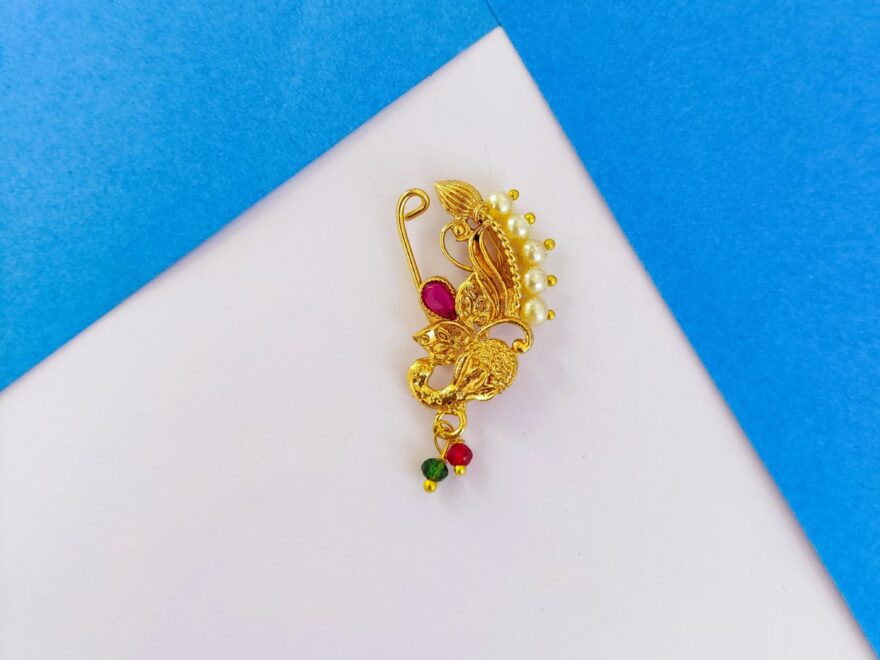Introduction:
In the kaleidoscope of Indian weddings, where traditions and modernity dance hand in hand, the nose ring, or “Nath,” has stood the test of time as a symbol of beauty, tradition, and cultural pride. This intricate piece of Indian gold-plated jewelry has adorned the faces of brides for centuries, evolving in design and style but maintaining its timeless charm. Join us on a journey through the captivating history of Indian wedding nose ring fashion, exploring the artistry, symbolism, and allure that make the Nath an indispensable part of the bridal ensemble.
Tracing the Timeless Evolution of Indian Wedding Nose Ring Fashion:
1. Ancient Roots:
The origins of the Indian wedding nose ring trace back to ancient times, when it symbolized more than just ornamentation. In Vedic culture, the nose ring was considered a symbol of wealth and prosperity, often crafted from gold to signify opulence and affluence. It was also believed to have therapeutic benefits, with Ayurvedic texts mentioning its use in alleviating various health issues. As centuries passed, the nose ring evolved from a symbol of status to an emblem of marital bliss, adorning brides on their sacred wedding day.
2. Medieval Majesty:
During the medieval period in India, the nose ring gained further prominence as intricate designs and embellishments emerged. With the Mughal influence, intricate patterns and gemstones found their way into nose ring designs, adding a touch of grandeur and luxury. Indian gold-plated jewelry became a staple in royal households, with the nose ring symbolizing not just beauty, but also power and prestige. It became customary for brides to wear elaborate nose rings as a testament to their regal lineage and marital status.
3. Colonial Charms:
The colonial era ushered in a blend of cultures, influencing Indian wedding nose ring fashion in unique ways. While traditional designs persisted, European influences introduced new materials and styles. Silver nose rings adorned with pearls and enamel became fashionable among the elite, reflecting a fusion of Indian and Western aesthetics. Despite colonial upheavals, the nose ring remained a steadfast symbol of tradition and heritage, cherished by brides as a link to their cultural roots.
4. Modern Marvels:
In contemporary times, Indian wedding nose ring fashion has embraced innovation while honoring tradition. Indian gold-plated jewelry continues to reign supreme, with modern brides opting for sleeker designs infused with contemporary elements. From minimalist studs to elaborate hoops, the versatility of nose ring styles reflects the diverse preferences of today’s brides. Furthermore, the resurgence of traditional craftsmanship has seen a revival of antique designs, celebrating the timeless beauty of vintage nose rings.
5. Symbolism and Significance:
Beyond its ornamental value, the Indian wedding nose ring carries profound symbolism in Hindu culture. It is believed to enhance a woman’s beauty and fertility, bestowing blessings upon the newlywed couple for a prosperous union. The piercing of the bride’s nose, known as “Nath utarna,” symbolizes her transition into married life, marking a significant rite of passage. Additionally, the nose ring serves as a visible symbol of marital status, signifying a woman’s commitment to her husband and family.
6. Trends and Traditions:
While traditional nose ring designs remain evergreen, contemporary trends have brought forth innovative interpretations. Brides today often opt for personalized nose rings that reflect their style and personality. From customized initials to modern motifs, these bespoke creations add a touch of modernity to traditional ensembles. Moreover, the influence of Bollywood and social media has propelled certain nose ring styles into the limelight, inspiring brides to emulate their favorite celebrity looks on their special day.
7. Celebrating Diversity:
It’s important to recognize that India is a land of diverse cultures and traditions, each with its unique interpretation of Indian wedding nose ring fashion. From the ornate Maharashtrian “Nath” to the delicate Kerala “Mukkuthi,” every region boasts its distinct nose ring styles, reflecting the rich tapestry of Indian heritage. These variations serve as a testament to the country’s cultural diversity, celebrating the beauty of unity in multiplicity.
Read More: Introduced Golden Elegance: The Latest Trend in Wholesale Jewelry
Conclusion:
The history of Indian wedding nose ring fashion is a testament to the enduring allure of tradition and craftsmanship. From ancient times to the modern era, nose rings have captivated hearts with their timeless beauty and symbolism. As Indian weddings continue to evolve, one thing remains constant—the irreplaceable charm of the nose ring, shining brightly as a beacon of love, tradition, and cultural heritage.
In the dazzling tapestry of Indian weddings, the nose ring stands as a shimmering symbol of tradition and timeless beauty. Whether crafted from gold, adorned with pearls, or embellished with precious gems, the nose ring has adorned brides for centuries, infusing their special day with grace, elegance, and splendor.
Frequently Encountered Conundrums
1. How does the evolution of Indian Wedding Nose Ring fashion resonate with trends in the USA?
Explore the fascinating journey of Indian Wedding Nose Ring fashion and its influence on the most popular styles in the USA today.
2. What makes Indian Jewelry Mall stand out in the realm of Indian jewelry?
Discover the unique features and specialties of our shop that make us a go-to destination for exquisite and authentic Indian nose ring designs.
3. Can you shed light on the cultural symbolism behind gold-plated chunky Indian necklace sets?
Uncover the deeper meanings and cultural symbols associated with the classic gold-plated chunky Indian necklace sets.

